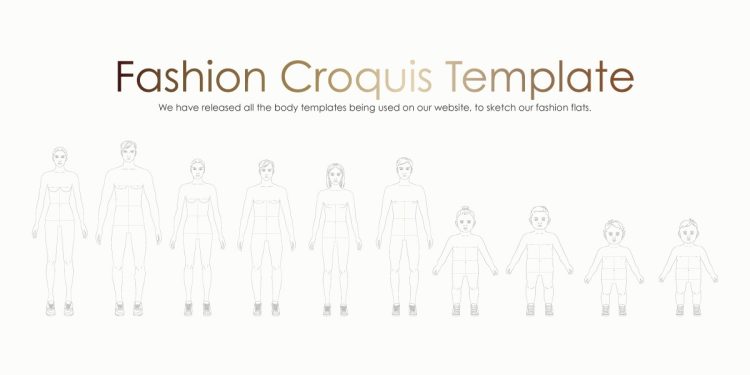Flat sketches are a great way of planning your line and designing! Flat sketches allow for easy visual access to the garment types and shapes, as well as their overall proportions and interchangeability. You can also draw them flat so you have more freedom to add details and not be restricted by a posed figure. While a posed figure can be useful for other purposes, it is not necessary to layer the garments. Sometimes working in flats is enough. You’ll see a variety in the presentation and design sketching of my Series Fashion Design and Illustration to get an idea of how they work and what makes sense for each occasion.
A fashion croquis/fashion flats template body is a great tool for creating sketches or creating a line sheet.
This keeps your proportions constant when you trace your garments on it. It also gives you a paper body that you can use to design your clothes. These templates can be printed again and again to design by placing a semi-transparent piece of copy or sketch paper on top and drawing outfits and fashion garments onto it. The above figures were drawn from a live model, but the results are a little distorted. The legs are too long for them to look natural. This can affect the proportions of the entire design and make it difficult to reproduce the skirts and pants that were drawn on them in real life.
These Straight figure fashion croquis template can be used to sketch flats for fashion design (fashion technical drawing) or to trace figures in static poses. This allows you to easily identify garment details and landmarks. Notice her legs appear long but her feet look longer.
It is crucial to be specific about your body in a grouping of designs. This will ensure that all communication about lengths and widths for garment components is clear and understandable by all involved in the production process. You can also have an aesthetic you feel proud of!
These flats were made by following the fashion croquis template. This keeps the proportions of each flat consistent in the presentation. Good layouts show front and back flats clearly on a well-designed page that is both visually appealing and stylish.
Flats templates/croquis will be used as our model’s body so that we can create on them. Although it’s a two-dimensional image, fashion design and the human body have three dimensions. It is important to take photos from different angles for bridal and evening wear, where a profile or rear view is crucial.
Tips For Creating Croquis Drawings
Croquis drawings are the first step to bringing fashion creations into life. You can start by creating a croquis from a pre-made fashion croquis template if this is your first attempt at drawing a garment. Here are some tips for drawing your croquis.
1. A thick piece of paper with a pencil and a lead pencil are the best tools to create croquis drawings.
2. To help you conceptualize your ideas, make a mood board before you put pen to paper. To create separate boards for fabric, colors, textures, or accessories, you can use magazines, photos, and street-style images.
3. Remember that croquis drawings have proportions that are not appropriate for the body. To exaggerate height, legs are extended. From top to bottom, the standard length of fashion figure template is nine times that of the drawn head.
4. Croquis drawings can have different poses to show the movement and best showcase the garment. To show the skirt’s design better, you can have one hand on the hip and the pelvic area tilted.
What are the purposes of Croquis Drawings?
Croquis’s sketches show the technical components of a garment.
- 1. Fit
- 2. Shape
- 3. Sleeve length
- 4. Overall length
- 5. Placement of seams and darts
These detailed fashion sketches convey the design to the pattern makers, who then can create a croquis from the sketch.
You can also use a croquis template to create different designs in a collection. Marc Jacobs, the fashion designer, uses the same croquis template for each season to help patternmakers understand how different garments should be structured to achieve a particular silhouette. Patternmakers can compare the shape, width, and height of different garments by using continuity between croquis sketches.













